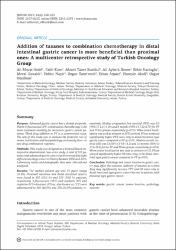Addition of taxanes to combination chemotherapy in distal intestinal gastric cancer is more beneficial than proximal ones: A multicenter retrospective study of Turkish Oncology Group

Göster/
Tarih
2019Yazar
Sedef, Ali MuratKöse, Fatih
Sümbül, Ahmet Taner
Beşen, Ali Ayberk
Hacıoğlu, Bekir
Günaldı, Meral
Tanrıverdi, Özgür
Üst veri
Tüm öğe kaydını gösterÖzet
Purpose: Advanced gastric cancer has a dismal prognosis. Platin/5-fluorouracil (PF) combination chemotherapy is the main treatment modality for metastatic gastric cancer patients. Third drug addition to PF is a controversial issue. The aim of this study was to evaluate the predictive role of tumor localization and histopathology on choosing three- or two-drug combination regimens. Methods: This study was designed as a hospital-based retrospective observational case-series study. A total of 516 patients with advanced gastric cancer has been treated at eight different oncology centers in Turkey between 2006 and 2016. Laboratory results and demographic data were collected and analyzed. Results: The median patient age was 59 years (range 25-85). Proximal intestinal and distal intestinal cancers were found in 357 (69.2 %) and 159 (30.8 %) patients, respectively. 5-fluorouracil (5FU) and cisplatin (PF) and cisplatin+5FU+docetaxel (PFtax, also known as DCF) were administered to 240 (46.5%) and 276 (53.5%) patients, respectively. Median progression free survival (PFS) was 5.0 (95% CI 4.21-5.29) and 8 months (95% CI 7.22-8.77)for PF and PFtax groups, respectively (p<0.01). When tumor localization was used as stratum in PFS survival, PFtax produced significantly higher PFS rates only in distal intestinal type gastric cancer compared to PF (p <0.01). Median overall survival (OS) was 12 (95% CI 9.8-14.2) and 16 months (95% CI 13.6-18.4)for the PF and PFtax groups, respectively (p=0.01). When tumor localization was used as stratum in OS, PFtax showed significantly higher OS rates only in the distal intestinal type gastric cancer compared to PF (p=0.01). Conclusion: Pathology and tumor location in gastric cancer may affect the outcome. Addition of taxanes as a third drug may significantly increase PFS and OS rates only in distal intestinal type gastric cancer but not in patients with proximal type gastric cancer.

















